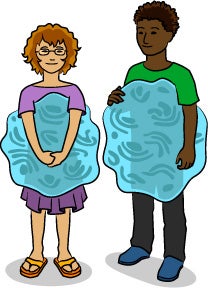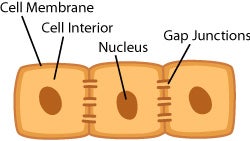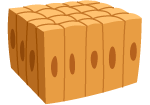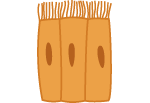Epithelial Cells
Where are epithelial cells?

Take a quick look at the skin on your hands. Even if you think your skin is one smooth surface, it is actually made of millions of epithelial cells that are tightly packed next to each other.
That’s not the only place you find these cells. Epithelial cells also line the inside of your throat, intestines, blood vessels, and all your organs. They are a barrier between the inside and outside of your body and are often the first place that is attacked by viruses as they begin their invasion deeper into the body.
What do epithelial cells do?
Epithelial cells are the safety shields of the body. Take another look at your hand. It is covered with epithelial cells that protect your body by being a barrier between your internal cells and the dirt and microbes in the environment. They also are able to stretch so you can move your fingers and arms into many positions. You can also thank your epithelial cells for making the sweat that cools you down when you're exercising or when it's hot outside. To learn more about your skin and the important ways it works for you every day, listen to this podcast.

Other epithelial cells help you experience your environment by having special sensors, called receptors, that collect signals. When you taste a favorite food or smell a flower, the receptors in these cells send the signal to your brain so you can enjoy every bite and sweet smell.
Once you swallow that bite of food, it travels down a path lined with epithelial cells. When it gets to your intestines, another set of epithelial cells absorbs and transports nutrients from the foods you eat and helps process it for energy your body can use. Converting food energy to energy your body can use is the work of molecules called enzymes. Once again, it is epithelial cells that make and secrete the enzymes in your stomach. Epithelial cells also secrete hormones into your blood vessels, mucus in your nose, and the breast milk which mothers feed their young.
What do epithelial cells look like?

If you take a close look at epithelial cells using a microscope, you will see them tightly packed together. This helps make a protective barrier for our bodies. There are also some special door-like connections between each epithelial cell called gap junctions. The gap junctions are where the cells exchange nutrients. Unfortunately, sometimes viruses can use these doors to spread between cells, too!
Epithelial cells come in different shapes depending on where in the body they're found. These shapes are called squamous, cuboidal, columnar, and ciliated columnar.
|
|
Squamous epithelial cells are flat and are usually found lining surfaces that require a smooth flow of fluid, such as your blood vessels. They also line areas that require a very thin surface for molecules to pass through, such as the air sacs in your lungs. |
 |
Cuboidal epithelial cells, as their name suggests, are shaped like cubes. These are typically found in tissues that secrete or absorb substances, such as in the kidneys and glands. |
 |
Columnar epithelial cells are long and thin, like columns. These are usually found in places that secrete mucus such as the stomach. They can also specialize to receive sensory information in places like taste buds on your tongue and inside of your nose. |
 |
Ciliated columnar cells have their apical (or outside facing) surface covered with many tiny little hairs called cilia. These are used to push mucus and other particles along, making it flow in a specific direction. |
In addition to these shapes, epithelial cells can be described as being either simple or stratified. These terms refer to how many layers are present. Simple tissue has only one layer of epithelial cells, while stratified tissue has many layers stacked on top of each other. Stratified cells are found in places that need to withstand a lot of wear and tear from their environment.

An example of this would be your skin, which is made up of many stratified layers of epithelial cells. As the top layer wears down, cells from the bottom layers constantly grow up to replace them.
Bibliographic details:
- Article: Epithelial Cells
- Author(s): Dr. Biology
- Publisher: Arizona State University School of Life Sciences Ask A Biologist
- Site name: ASU - Ask A Biologist
- Date published:
- Date accessed:
- Link: https://askabiologist.asu.edu/epithelial-cells
APA Style
Dr. Biology. (). Epithelial Cells. ASU - Ask A Biologist. Retrieved from https://askabiologist.asu.edu/epithelial-cells
Chicago Manual of Style
Dr. Biology. "Epithelial Cells". ASU - Ask A Biologist. . https://askabiologist.asu.edu/epithelial-cells
Dr. Biology. "Epithelial Cells". ASU - Ask A Biologist. . ASU - Ask A Biologist, Web. https://askabiologist.asu.edu/epithelial-cells
MLA 2017 Style
Be Part of
Ask A Biologist
By volunteering, or simply sending us feedback on the site. Scientists, teachers, writers, illustrators, and translators are all important to the program. If you are interested in helping with the website we have a Volunteers page to get the process started.



